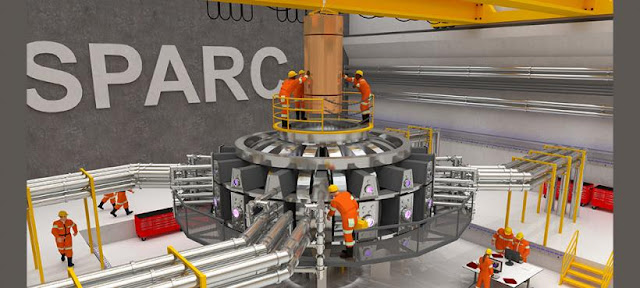Anyone looking for a bright side in the climate crisis may want to learn about a potentially revolutionary research project that could help redefine energy as we know it. Researchers are gathering at a meeting of the American Physical Society Division of Plasma Physics in Portland, Oregon, this week to deliver a kind of state-of-the-science report on fusion energy, the space-age technology that promises essentially infinite and carbon-free electrical power.
Scientists from MIT and the privately funded energy company Commonwealth Fusion Systems (CFS) are presenting critical updates on their SPARC project, an effort to manufacture the world’s first fusion power generator. If successful, the accomplishment could, like the Wright brothers’ first flights at Kitty Hawk, change everything.
Fusion energy is a form of power generation in which energy is produced through controlled nuclear fusion reactions, which is essentially the same process that powers the sun and other stars. Fusion occurs when the nuclei of small atoms bind together (or fuse) into a single, larger atom, releasing colossal amounts of energy in the process.
For terrestrial utility purposes, that energy can then be harnessed to provide the heat required for various kinds of electricity generation. A fusion energy plant could potentially operate entirely carbon-free and issue very little waste material, while at the same time offering ridiculously powerful energy yields. Theoretically, it would be the ultimate alternative energy source, deriving power from the same process that lights up the cosmos.
But generating fusion energy on Earth presents some daunting challenges. The process requires superheating a dense plasma of subatomic particles inside a fusion device called a tokamak at extremely high temperatures — like, inside-of-a-star kind of temperatures, millions of degrees Fahrenheit, which is too intense for solid materials to contain.
Small fusion reactions, isolated from ordinary matter within magnetic fields, have been produced in labs. But so far, the conditions for net energy gain haven’t been achieved. The trick, scientists hope, is to strengthen those magnetic fields. In the initial three-year phase of their collaboration, SPARC researchers are trying to build the world’s most powerful superconducting magnet, which in turn could make possible the world’s first viable fusion generator by increasing its effectiveness while reducing its volume and cost.
“By putting the magnet development up front, we think that this gives you a really solid answer in three years,” said Dennis Whyte, director of MIT’s Plasma Science and Fusion Center, in March, “and gives you a great amount of confidence moving forward that you’re giving yourself the best possible chance of answering the key question, which is: Can you make net energy from a magnetically confined plasma?”
The building of magnets at the necessary scale will require a new class of high-temperature superconductors — and the big news is that the SPARC has figured this out. Superconductors are materials that conduct electricity with absolutely no electrical resistance, so no energy is lost. The catch is that in order for them to do so, superconductors need to be very cold, maintaining a temperature below a critical threshold.
The SPARC team says that it has found a way to manufacture breakthrough high-temperature superconductors in the form of “tapes” or “ribbons” that will enable fusion at scale. But they have yet to be incorporated into appropriately sized magnets and aren’t suited for existing fusion machines.
After creating a superconducting magnet with unprecedented performance, the next step will be to design and construct the long-anticipated SPARC fusion reactor, which will aim to produce more energy than it consumes. The MIT and CFS researchers expect that SPARC will be running by 2025, with a modest output of between 50MW and 100MW, which is roughly enough to power a small city.
But SPARC is just an experiment. The idea is that its demonstration will lead to the building of a net-electricity producing fusion pilot plant and, in turn, a new class of commercial fusion power plants. Other experimental reactors of this type are already in development around the world, but with climate change troubles approaching fast, the SPARC crew is working to dramatically speed up development on their iteration of the technology.
According to MIT’s online project page, a successful run of the SPARC reactor “will demonstrate that fusion energy can be developed in time to provide carbon-free power to combat climate change.” The billion-dollar question, of course, is when. MIT scientists believe that a viable fusion pilot plant could be built and plugged into the grid in about 15 years.
